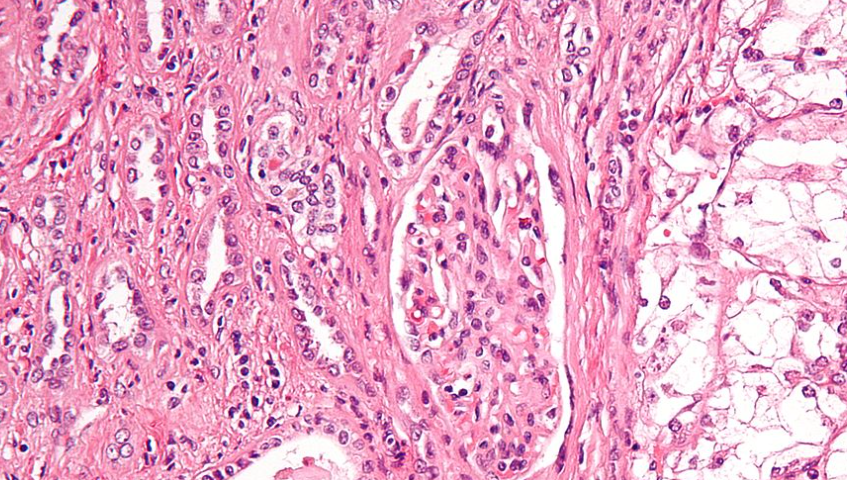Makindo Medical Notes"One small step for man, one large step for Makindo" |
|
|---|---|
| Download all this content in the Apps now Android App and Apple iPhone/Pad App | |
| MEDICAL DISCLAIMER: The contents are under continuing development and improvements and despite all efforts may contain errors of omission or fact. This is not to be used for the assessment, diagnosis, or management of patients. It should not be regarded as medical advice by healthcare workers or laypeople. It is for educational purposes only. Please adhere to your local protocols. Use the BNF for drug information. If you are unwell please seek urgent healthcare advice. If you do not accept this then please do not use the website. Makindo Ltd. |
Renal cell carcinoma
-
| About | Anaesthetics and Critical Care | Anatomy | Biochemistry | Cardiology | Clinical Cases | CompSci | Crib | Dermatology | Differentials | Drugs | ENT | Electrocardiogram | Embryology | Emergency Medicine | Endocrinology | Ethics | Foundation Doctors | Gastroenterology | General Information | General Practice | Genetics | Geriatric Medicine | Guidelines | Haematology | Hepatology | Immunology | Infectious Diseases | Infographic | Investigations | Lists | Microbiology | Miscellaneous | Nephrology | Neuroanatomy | Neurology | Nutrition | OSCE | Obstetrics Gynaecology | Oncology | Ophthalmology | Oral Medicine and Dentistry | Paediatrics | Palliative | Pathology | Pharmacology | Physiology | Procedures | Psychiatry | Radiology | Respiratory | Resuscitation | Rheumatology | Statistics and Research | Stroke | Surgery | Toxicology | Trauma and Orthopaedics | Twitter | Urology
Related Subjects: |Urothelial tumour s |Haematuria |Acute Urinary Retention |Anuria and Oliguria |Bladder cancer |Renal cell carcinoma |Benign Prostatic Hyperplasia |IgA nephropathy |Prostate Cancer |Henoch-Schonlein purpura |Glomerulonephritis
🔎 About
- 🧬 Renal cell carcinoma (RCC) is the most common renal tumour in adults.
- 👨🦳 Typically affects age 50+ and is 2–3x more common in males.
🧬 Aetiology
- Genetic Factors:
- 🧩 Von Hippel-Lindau (VHL) syndrome: Mutation of VHL tumour suppressor gene.
- 🧬 Hereditary Papillary RCC (HPRC): Autosomal dominant predisposition.
- Other: Birt-Hogg-Dubé, hereditary leiomyomatosis.
- Lifestyle Factors:
- 🚬 Smoking = major risk factor.
- ⚖️ Obesity = increases RCC risk.
- Medical Conditions:
- 📈 Hypertension = established risk.
- 🩺 CKD + long-term dialysis predispose to RCC.
- Occupational Exposures:
- 🏭 Cadmium, asbestos, industrial dyes (β-naphthylamine, benzidine).
🧫 Histology
- Originates in the renal tubular epithelium; ~10% bilateral.
- ➕ >10 histological and molecular subtypes.
- Clear cell RCC (ccRCC): ~75–80% of cases, most lethal, VHL gene mutations.
⚠️ Risk Factors
- 👨 Male gender.
- 🚬 Smoking, ⚖️ obesity, 📈 hypertension, CKD.
- 🩸 Haemodialysis, kidney transplant, acquired cystic kidney disease.
- 📜 Previous RCC diagnosis; ?diabetes link.
🩺 Clinical Features
- Symptoms: 🩸 Haematuria, flank pain, abdominal mass, weight loss, fever.
- Paraneoplastic: ectopic hormones → 🩸 polycythaemia (EPO), 🧾 hypercalcaemia (PTHrp), ACTH, renin, prolactin.
- 🍇 Left varicocele (compression of left testicular vein).
- 🌍 Metastases → lungs, liver, bones, brain.
- 🩸 May invade renal vein → IVC → right atrium (tumour thrombus).
🔍 Investigations
- 💉 Urinalysis: haematuria, malignant cells.
- 📊 FBC: anaemia or polycythaemia.
- Imaging:
- 🖥️ USS: renal mass, venous extension.
- 🖼️ CT: key for staging + operative planning.
- 🧲 MRI: venous involvement, complex spread.
- 📷 CXR: “cannonball” lung metastases.
- 🧪 Biopsy: histology + subtype confirmation.
💡 RCC arises from renal tubule epithelium. Clear cell RCC = most common, VHL gene mutation, accounts for majority of deaths.

🛠️ Management
- General: 🚭 Stop smoking, ⚖️ weight management.
- Surgery:
- 🔪 Partial nephrectomy (localized disease, nephron-sparing).
- ⚡ Radical nephrectomy: kidney + adrenal + LN dissection.
- Local Therapies: RFA (heat), cryoablation (cold).
- Radiotherapy: 🎯 Mainly palliative for mets.
- Systemic Therapy:
- 🛡️ Immunotherapy: checkpoint inhibitors (nivolumab, pembrolizumab).
- 🎯 Targeted therapy: TKIs (sunitinib, pazopanib), mTOR inhibitors.
- 💊 FGFR/VEGF inhibitors for selected genetic profiles.
- Prognosis:
- 📍 Localized disease: ~60% 5-year survival.
- 🌍 Metastatic disease: ~5% 5-year survival.
Case 1
58-year-old smoker with intermittent painless haematuria and dull right flank pain; renal US shows a solid cortical lesion and contrast CT (renal protocol) confirms a 5.2 cm enhancing upper pole mass without nodes or vein thrombus; labs reveal mild anaemia and ↑ALP; MDT plans nephron-sparing surgery with partial nephrectomy (T1b, favourable anatomy) to preserve renal function; no pre-op biopsy given classic imaging; pathology later shows clear cell RCC with negative margins—post-op plan: risk-adapted CT chest/abdomen surveillance, eGFR monitoring, and smoking cessation.
Case 2
72-year-old with weight loss, bone pain, and hypercalcaemia; staging CT demonstrates an 8 cm left renal mass with renal vein/IVC thrombus and pulmonary nodules; MRI maps thrombus extent; per MDT, tissue diagnosis obtained because systemic therapy precedes surgery; commence immunotherapy/VEGF-TKI combination per IMDC risk, treat hypercalcaemia (IV fluids + bisphosphonate/denosumab), and consider cytoreductive nephrectomy only if good performance status and response to systemic therapy; palliative radiotherapy for painful bone metastases as needed.